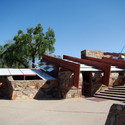
-
Architects: Frank Lloyd Wright
- Year: 1959
-
Photographs:Flickr User: godutchbaby
Text description provided by the architects. Situated in the Sonoran desert outside of Scottsdale, Arizona stands a living memorial and testament to the life and work of Frank Lloyd Wright. Completed between 1937 - 1959, Taliesin West was the winter home to Wright and his wife’s summer home, Taliesin, in Spring Green, Wisconsin in addition to being Wright’s workshop and school for his apprentices.


























